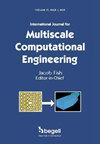帕特里齐亚·特罗瓦鲁西:一个思想开放的力学学者,一个建筑师,一个坚定的女人
IF 1.4
4区 工程技术
Q2 ENGINEERING, MULTIDISCIPLINARY
International Journal for Multiscale Computational Engineering
Pub Date : 2022-01-01
DOI:10.1615/intjmultcompeng.2022045251
引用次数: 0
摘要
在拉奎拉大学工程学院度过了近20年之后,我在1995年回到了罗马Sapienza大学,这分别是我的家乡大学和我的家乡城市。我在那里完成了我学术生涯的所有主要最初步骤。拉奎拉是一次非常有益的科学成长和个人成熟的经历。然而,这段时间也很辛苦,因为我的妻子是那不勒斯美术学院的教授,我的两个孩子住在罗马。也许,习惯了不同大学和主办城市之间高度渗透的外国同事会对这一观察结果感到困惑。但是,意大利的社会、文化和学术环境一直以强烈的地方认同感为特征,特别是当科学活动的最初地点是一所著名的大学时(幸运的是,这种观念在最近几十年几乎完全消失了)。在罗马建筑学院结构与岩土工程系的分院,我找到了Patrizia Trovalusci,她是一位优秀且非常积极的年轻研究员(终身职位相当于助理教授),我已经在几次会议上见过她,她在三年前获得了博士学位。由于对建筑学院的特殊环境缺乏经验,我尽量不像一头大象进了水晶店一样搬到那里去,而且我基本上做到了。特别是,我非常注意不发挥一个新教授的学术权力,我被任命建立一个固体和结构力学的质量团队,把我在结构和机械系统非线性动力学方面的科学背景的丰富性,以及“重量”和复杂性带到一个基本上不了解它们的环境中,而不是活跃在一个不同的领域。对于我的“助手”Patrizia来说尤其如此,她刚刚与一位年长的同事共同撰写了一些关于连续模式砌体的有趣论文。在接下来的几年里,我花了一些不平凡的努力,以适当地了解在各向异性不连续材料的微极和经典连续的更一般的研究项目中确实有多大的潜力,Patriz在这方面的工作是逐步和富有成果的。事实上,考虑到在不同的研究领域促进和支持一个前所未有的、即使数量很少的高质量群体的重要性,我坚持认为,不要将Patrizia的科学活动重新定向到非线性和混沌动力学的全新领域,让她在这方面有充分的选择和责任自由。事实上,这是(现在仍然是)我对在任何科学环境中促进研究进步的正确方法的概念立场。我做了这样的选择,尽管Patrizia的高品质作为一个科学家,我容易理解,尽管有些胆小,甚至fearful-attempts在她这边参与我参考的科学领域,甚至完全未知的她,尽管我强烈需要创建一个ne w d合格的本地团队在非线性动力学可能取代国际知名的est abli hed,主持在拉奎拉,直到放弃个人的遗憾。在后一方面,我含蓄而又慷慨地选择了像一个流亡的科学家一样生活在自己的国家,使自己适应于只与外部的人寻求科学合作,无论他们是来自我的新部门的工程部门(然而,相当封闭和排他性)还是来自其他大学,或来自国际关系。当然,我清楚地向Patrizia表达了我对她的科学信心,提供了给她自由选择的原因,甚至我自己也向她的研究领域迈出了几步,即使只是在有限的程度上考虑到我在非线性动力学领域的承诺的数量和丰富:在第一阶段,我们关注的是一些有趣的“软”问题,比如力学(实体和结构)、应用数学和(历史和当代)建筑设计之间的关系,幸运的是,我们没有关注这些问题本文章由计算机程序翻译,如有差异,请以英文原文为准。
Patrizia Trovalusci: An Open-Minded Scholar of Mechanics, an Architect, a Determined Woman
After spending nearly 20 years at the School of Engineering o f the University of L’Aquila, where I made all the main initial steps of my academic career, in 1995, I returned to the Sapienza University of Rome, which were my home university and my native city, respectively. L’Aquila w s a highly rewarding experience of scientific growth and personal maturation. Yet, it was also quite a demanding time because of my wife, professor at the Academy of Fine Arts of Naples, and my two kids living in Rome. Probably, fore ign colleagues accustomed to a great permeability between different universities and hosting cities will be a mazed by this observation. But, the Italian social, cultura , and academic environment has always been characterized by a strong sense of local identity, in particular when the original place of scientific activity was a prestigious u niversity (a perception which, luckily, has almost entirel y vanished in recent decades). At the branch of the Department of Structural and Geotechnic al Engineering of the School of Architecture of Rome, I found Patrizia Trovalusci, a fine and highly motivate d young researcher (a tenured position equivalent to an assistant professor) whom I had already met at a couple of con ferences, and who had received her PhD degree three years before. Being quite inexperienced of the peculiar env iro ment of a school of architecture, I did my best for not moving there like an elephant in a crystal shop, and I subs tantially succeeded in this. In particular, I paid strong attention in not exerting the academic power of a new profess r, appointed to establish a quality team in solid and structural mechanics, for bringing the richness, but also t he “weight” and complexity, of my scientific background in nonlinear dynamics of structures and mechanical systems into an environment substantially unaware of them and instead promisingly active in a different field. This was esp ecially true as regards my “assistant” Patrizia, who was just coauthoring some interesting papers on continuum mode ls f masonry, along with an older colleague. In the few years to come, I took some nontrivial effort to properly gras p how much potential was indeed embedded in the more general research program on micropolar and classical conti nua for anisotropic discontinuous materials, which Patriz i was progressively and fruitfully working on. And indeed, ca tching the importance of promoting and supporting an unprecedented, even if quantitatively minimal, quality gr oup also in a different area of research, I maintained the poi nt of not reorienting Patrizia’s scientific activity towards t he completely new area of nonlinear and chaotic dynamics, leaving her full freedom of choice and responsibility in thi s respect. As a matter of fact, this was (and still is) my conceptual position about the correct way to foster the adva ncement of research in whatever scientific environment. I made such a choice despite the high qualities of Patrizia as a scientist, which I readily grasped, despite some timid— and perhaps even fearful—attempts on her side to be involved in my scientific field of reference, completely unknown to her, and even notwithstanding my strong need to create a ne w a d qualified local team in nonlinear dynamics to possibly replace the internationally renowned one I had est abli hed and chaired in L’Aquila until abandoning it with personal regret. In this latter respect, I implicitly and al so somehow generously chose to live like an exiled scientist in his own country, adapting myself to seeking scientific col laborations only with external people, whether they were from the engineering branch (however, quite closed and excl usive) of my new department or from other universities, or international connections. Of course, I clearly manifes ted to Patrizia my scientific confidence in her, providing the reasons behind the freedom of choice left to her, and even tak i g a few steps towards her field of research myself, even if only to a limited extent given the quantity and richne ss of my commitments in the area of nonlinear dynamics: steps that were concerned, in a first stage, with some intrigu ing “soft” issues about the relations among mechanics (of solids and structures), applied mathematics, and (hist orical and contemporary) architectural design, luckily no t
求助全文
通过发布文献求助,成功后即可免费获取论文全文。
去求助
来源期刊
CiteScore
3.40
自引率
14.30%
发文量
44
审稿时长
>12 weeks
期刊介绍:
The aim of the journal is to advance the research and practice in diverse areas of Multiscale Computational Science and Engineering. The journal will publish original papers and educational articles of general value to the field that will bridge the gap between modeling, simulation and design of products based on multiscale principles. The scope of the journal includes papers concerned with bridging of physical scales, ranging from the atomic level to full scale products and problems involving multiple physical processes interacting at multiple spatial and temporal scales. The emerging areas of computational nanotechnology and computational biotechnology and computational energy sciences are of particular interest to the journal. The journal is intended to be of interest and use to researchers and practitioners in academic, governmental and industrial communities.

 求助内容:
求助内容: 应助结果提醒方式:
应助结果提醒方式:


